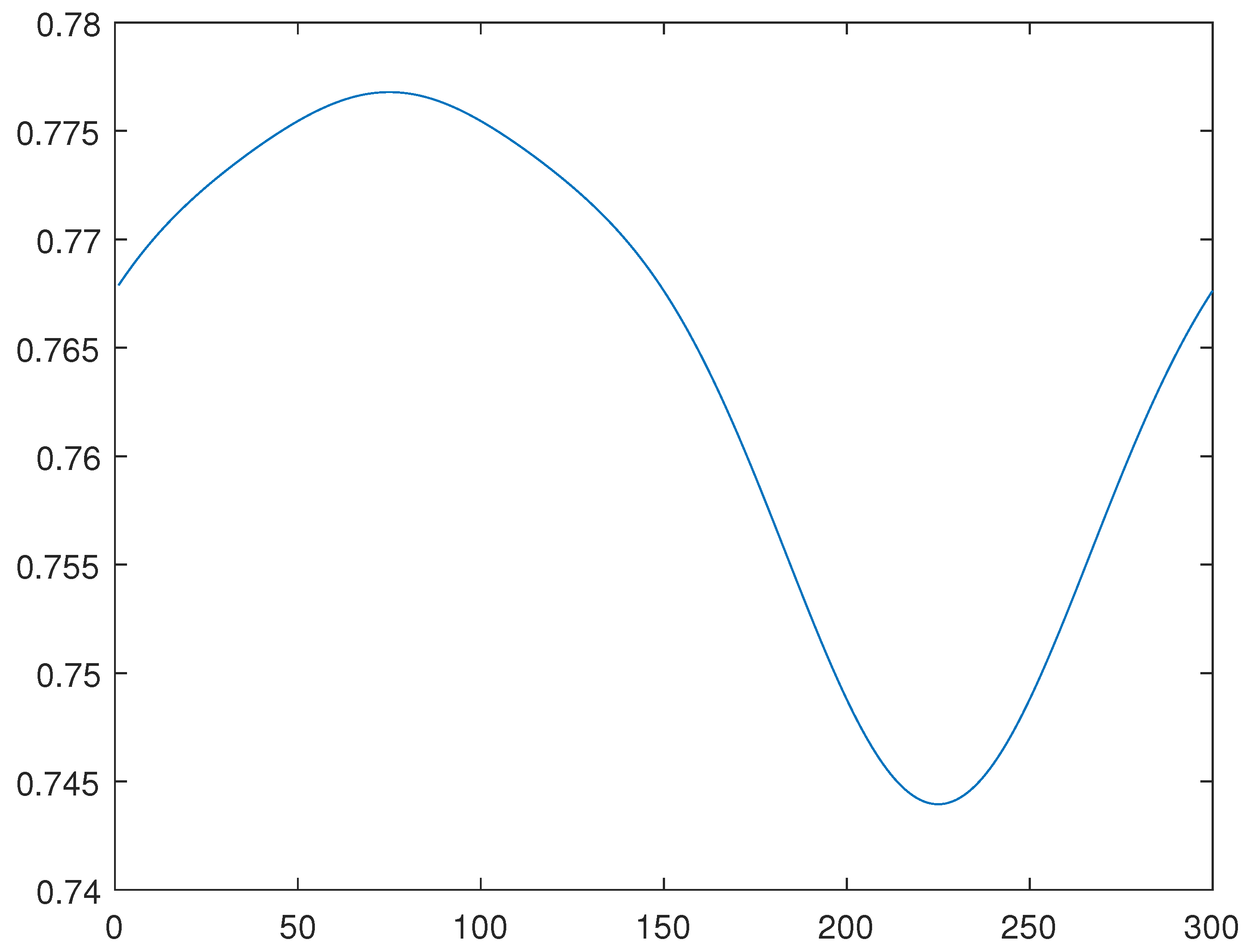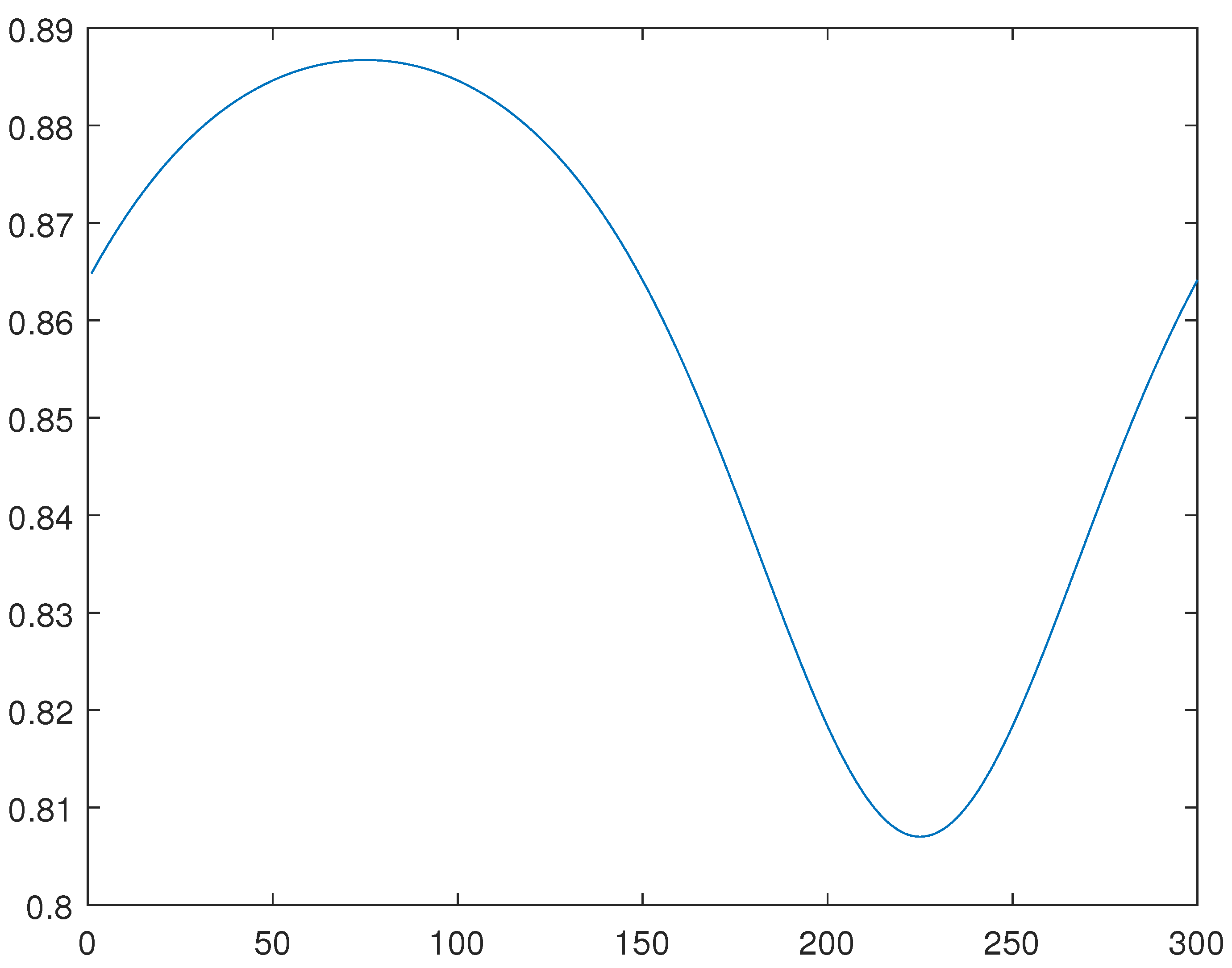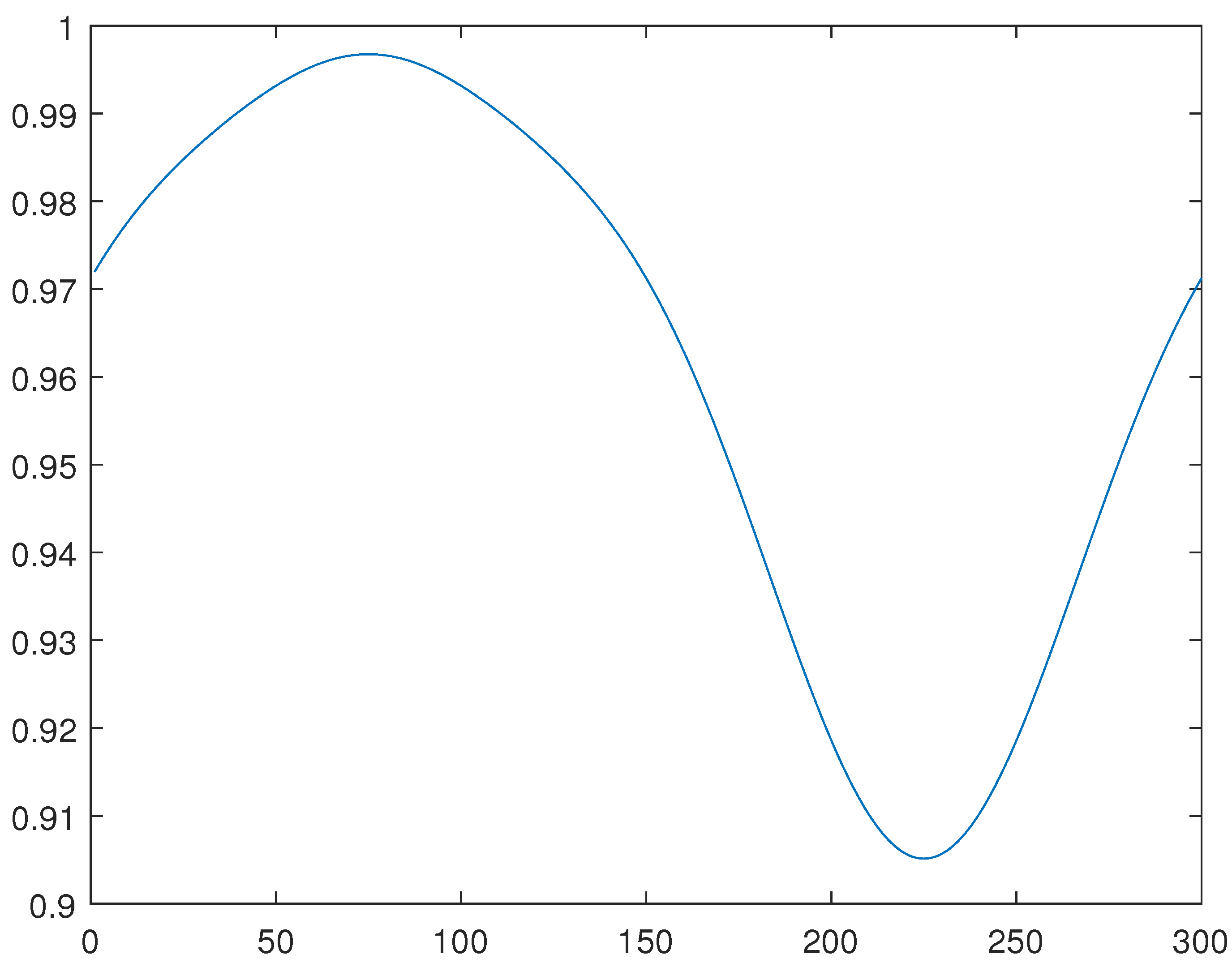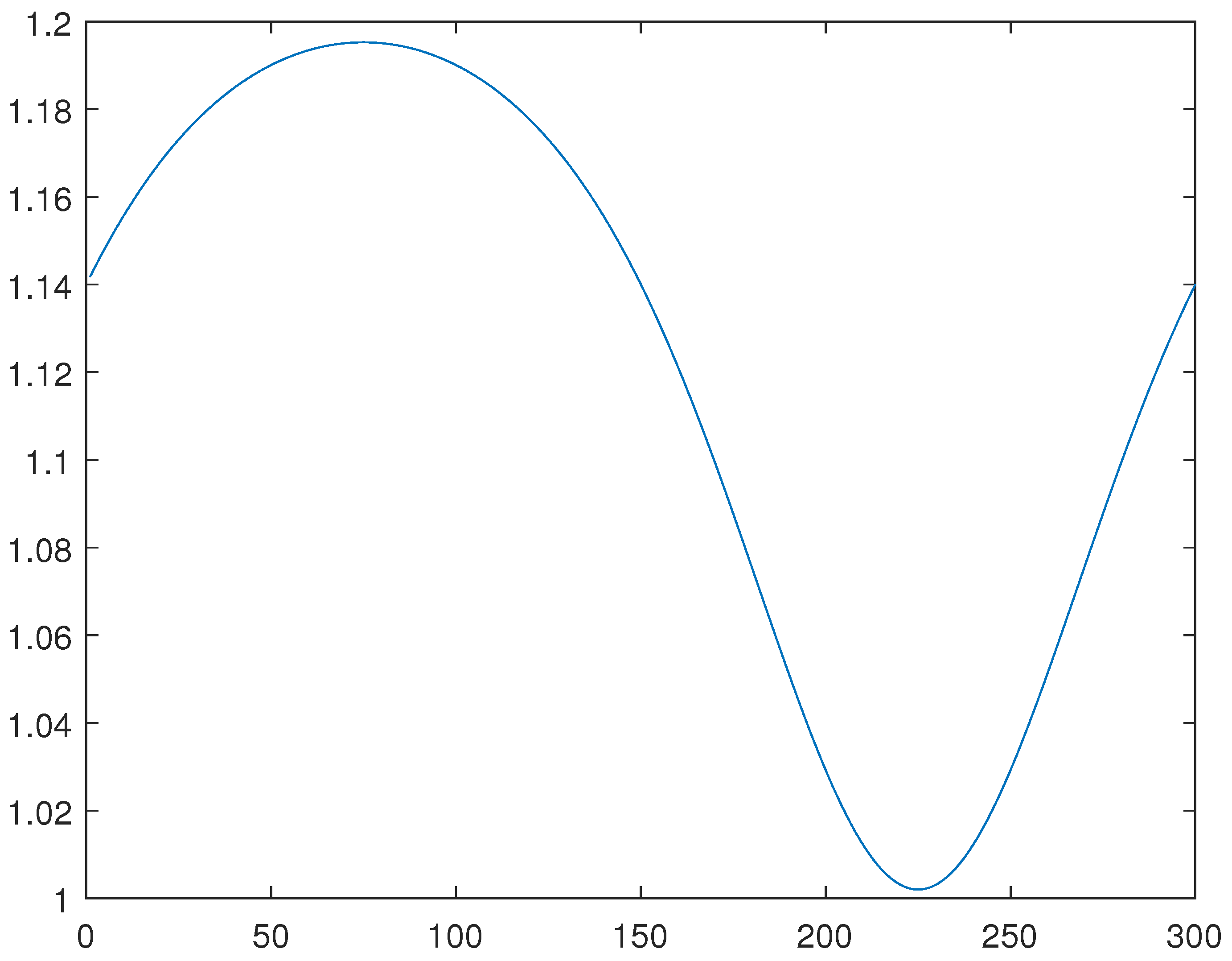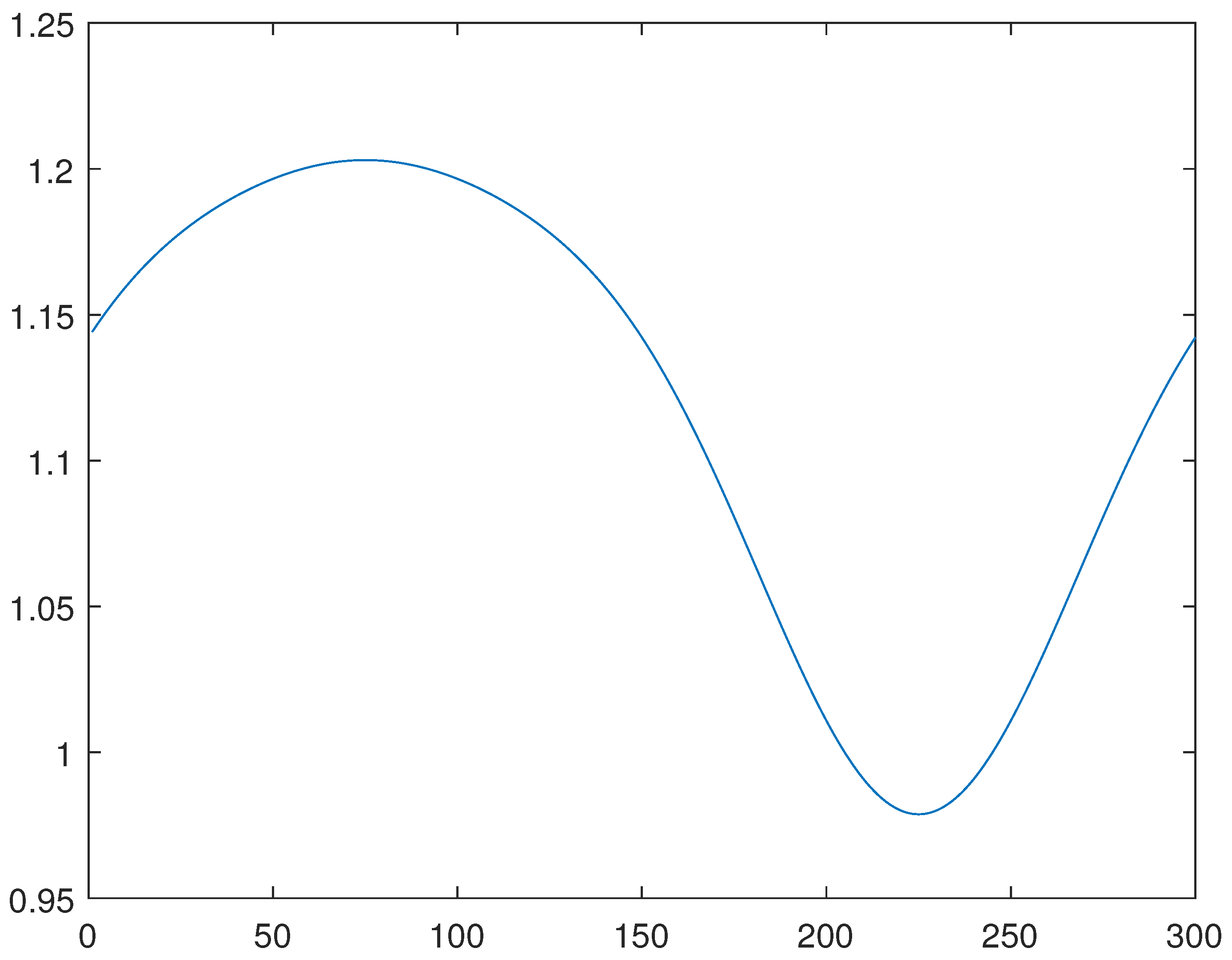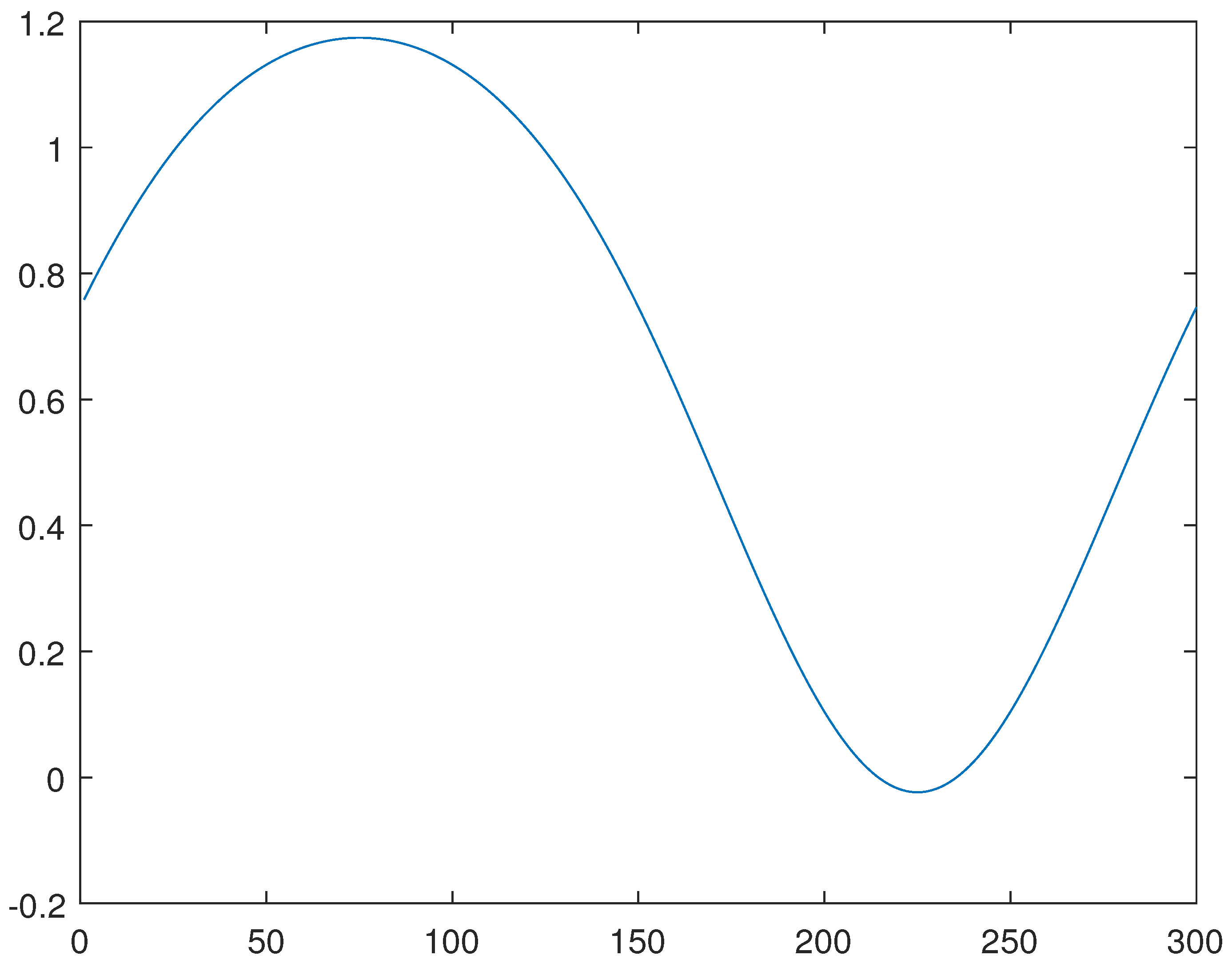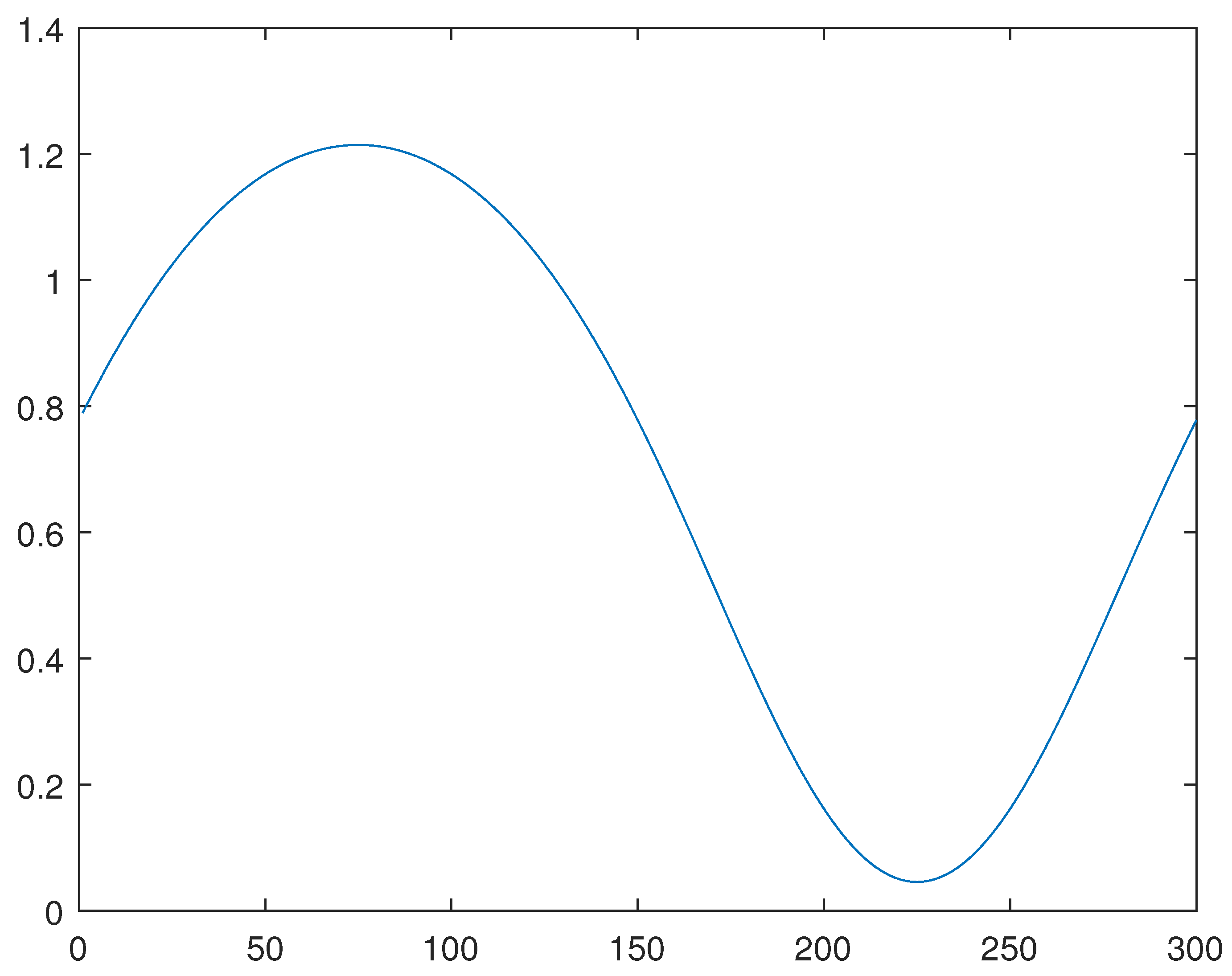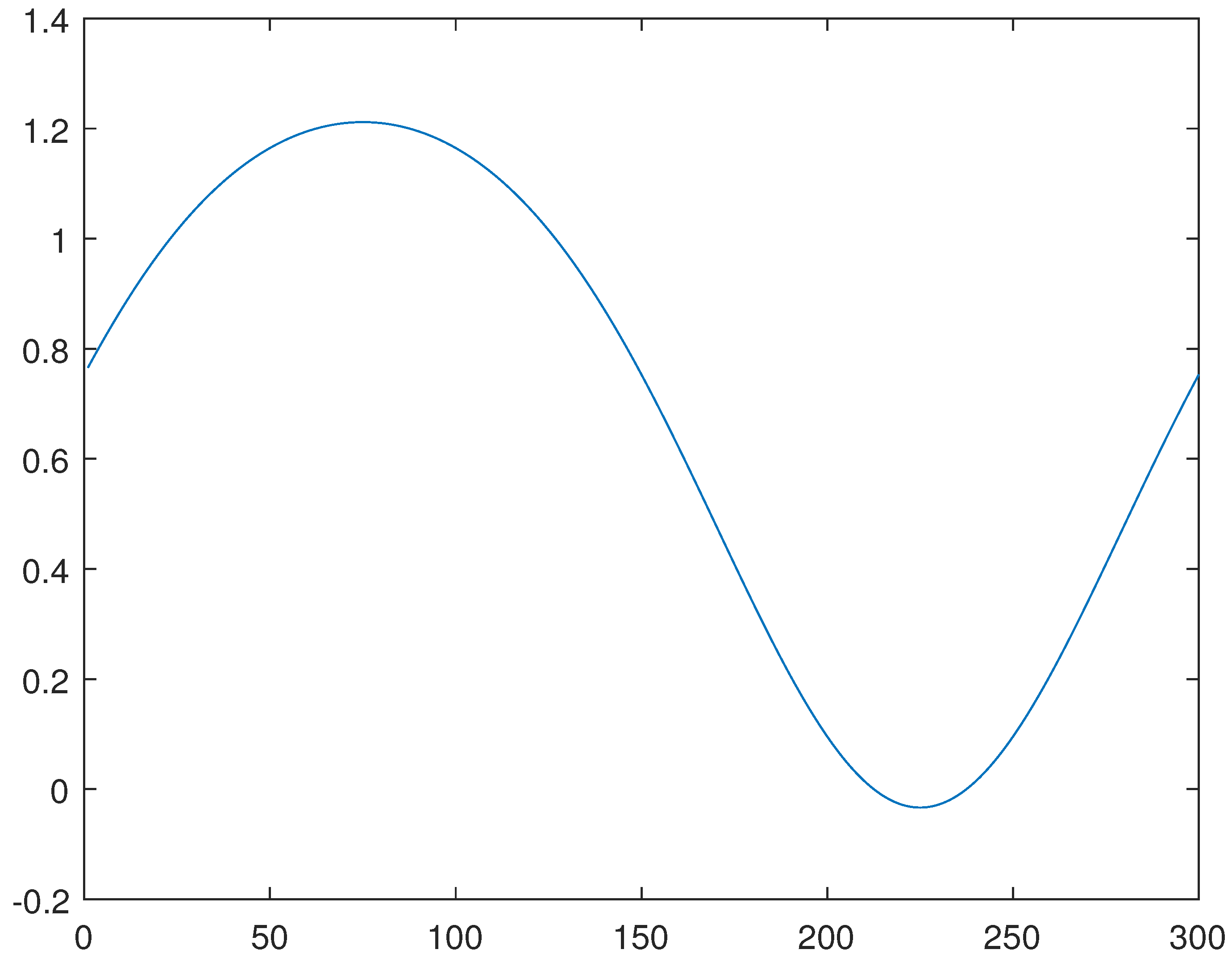1. Introduction
In this section, we establish a dual formulation for a large class of models in non-convex optimization.
The main duality principle is applied to the Ginzburg–Landau system in superconductivity in the absence of a magnetic field.
Such results are based on the works of J.J. Telega and W.R. Bielski [
1,
2,
3,
4] and on a D.C. optimization approach developed in Toland [
5].
About the other references, details on the Sobolev spaces involved are found in [
6]. Related results on convex analysis and duality theory are addressed in [
7,
8,
9,
10]. Finally, similar models on the superconductivity physics may be found in [
11,
12].
Remark 1. It is worth highlighting that we may generically denotesimply bywhere denotes a concerning identity operator. Other similar notations may be used along this text as their indicated meaning are sufficiently clear.
Additionally, denotes the Laplace operator, and for real constants and , the notation means that is much larger than
Finally, we adopt the standard Einstein convention of summing up repeated indices, unless otherwise indicated.
In order to clarify the notation, here, we introduce the definition of topological dual space.
Definition 1 (Topological dual spaces)
. Let U be a Banach space. We define its dual topological space as the set of all linear continuous functionals defined on U. We suppose that such a dual space of U may be represented by another Banach space , through a bilinear form (here, we are referring to standard representations of dual spaces of Sobolev and Lebesgue spaces). Thus, given linear and continuous, we assume the existence of a unique such thatThe norm of f, denoted by , is defined as At this point, we start to describe the primal and dual variational formulations.
Let be an open, bounded, connected set with a regular (Lipschitzian) boundary denoted by
First, we emphasize that, for the Banach space
, we have
For the primal formulation, we consider the functional
, where
Here, we assume
,
,
. Moreover, we denote
Define also
by
by
and
by
where
It is worth highlighting that in such a case,
Furthermore, define the following specific polar functionals specified, namely,
by
by
if
, where
At this point, we give more details about this calculation.
Defining
we have
so that
where
are solution of equations (optimality conditions for such a quadratic optimization problem)
and
and therefore,
and
Substituting such results into (
7), we obtain
if
Finally,
is defined by
Define also
by
and
by
2. The Main Duality Principle, a Convex Dual Formulation, and the Concerning Proximal Primal Functional
Our main result is summarized by the following theorem.
Theorem 1. Considering the definitions and statements in the last section, suppose also that is such thatUnder such hypotheses, we haveand Proof. Since
from the variation in
, we obtain
so that
From the variation in
, we obtain
From the variation in
, we also obtain
and therefore,
From the variation in
u, we have
and, thus,
Finally, from the variation in
, we obtain
so that
that is,
From such results and
, we have
so that
Additionally, from this and from the Legendre transform proprieties, we have
and thus, we obtain
Finally, by a simple computation, we may obtain the Hessian
in
, so that we may infer that
is concave in
in
.
Therefore, from this, (
13) and (
14), we have
The proof is complete. □
3. A Primal Dual Variational Formulation
In this section, we develop a more general primal dual variational formulation suitable for a large class of models in non-convex optimization.
Consider again
, and let
and
be three times Fréchet differentiable functionals. Let
be defined by
Assume that
is such that
and
Denote
, define
by
Denoting
and
, define also
for an appropriate
to be specified.
Observe that in
, the Hessian of
is given by
From this, we may infer that
and
Moreover, for sufficiently big, is convex in a neighborhood of .
Therefore, in the last lines, we have proven the following theorem.
Theorem 2. Under the statements and definitions of the last lines, there exist and such thatand is such thatMoreover, is convex in 4. One More Duality Principle and a Concerning Primal Dual Variational Formulation
In this section, we establish a new duality principle and a related primal dual formulation.
The results are based on the approach of Toland [
5].
4.1. Introduction
Let be an open, bounded, connected set with a regular (Lipschitzian) boundary denoted by
Let
be a functional such that
where
.
Suppose
are both three times Fréchet differentiable convex functionals such that
and
Assume also that there exists
such that
Moreover, suppose that if
is such that
then
At this point, we define
by
where
Observe that
so that
On the other hand, clearly, we have
so that we have
Let .
Since
J is strongly continuous, there exist
and
such that
From this, considering that is convex on V, we may infer that is continuous at u,
Hence, is strongly lower semi-continuous on V, and since is convex, we may infer that is weakly lower semi-continuous on V.
Let
be a sequence such that
Suppose that there exists a subsequence
of
such that
From the hypothesis, we have
which contradicts
Therefore, there exists
such that
Since
V is reflexive, from this and the Katutani Theorem, there exists a subsequence
of
and
such that
Consequently, from this and considering that
is weakly lower semi-continuous, we have
so that
Define
by
and
Defining also
by
from the results in [
5], we may obtain
so that
Suppose now that there exists
such that
From the standard necessary conditions, we have
so that
From these last two equations, we obtain
From such results and the Legendre transform properties, we have
so that
and
so that
4.2. The Main Duality Principle and a Related Primal Dual Variational Formulation
Considering these last statements and results, we may prove the following theorem.
Theorem 3. Let be an open, bounded, connected set with a regular (Lipschitzian) boundary denoted by
Let be a functional such thatwhere . Suppose are both three times Fréchet differentiable functionals such that there exists such thatand Assume also that there exists and such that Assume that is such that Assume that is such that if , then Define byand Define also byand Observe that since is such thatwe have Let be a small constant.
Under such hypotheses, defining bywe have Proof. Observe that from the hypotheses, and the results and statements of the last subsection,
where
Moreover, we have
Additionally, from hypotheses and the results in the last subsection,
so that clearly, we have
From these results, we may infer that
The proof is complete. □
Remark 2. At this point, we highlight that has a large region of convexity around the optimal point , for sufficiently large and corresponding sufficiently small.
Indeed, observe that for ,where is such that Taking the variation in in this last equation, we obtainso that On the other hand, from the implicit function theorem,so thatand Similarly, we may obtainand From this, we haveabout the optimal point 5. A Convex Dual Variational Formulation
In this section, again for
, an open, bounded, connected set with a regular (Lipschitzian) boundary
,
and
, we denote
,
and
by
and
We define also
and
and
by
and
if
, where
for some small real parameter
and where
denotes a concerning identity operator.
Finally, we also define
Assuming
by directly computing
, we may obtain that for such specified real constants,
is convex in
and it is concave in
on
Considering such statements and definitions, we may prove the following theorem.
Theorem 4. Let be such thatand be such that Under such hypotheses, we haveso that Proof. Observe that
so that, since
is convex in
and concave in
on
, we obtain
From
we have
and thus,
From
we obtain
and thus,
Finally, denoting
from
we have
so that
Observe now that
so that
The solution for this last system of Equations (
30) and (
31) is obtained through the relations
and
so that
and
and hence, from the concerning convexity in
u on
V,
Moreover, from the Legendre transform properties
so that
Joining the pieces, we have
The proof is complete. □
Remark 3. We could have also definedfor some small real parameter . In this case, is positive definite, whereas in the previous case, is negative definite. 6. Another Convex Dual Variational Formulation
In this section, again for
, an open, bounded, connected set with a regular (Lipschitzian) boundary
,
and
, we denote
,
and
by
and
We define also
and
and
by
and
At this point, we define
where
and
Finally, we also define
and
by
By directly computing , we may obtain that for such specified real constants, is concave in on
Indeed, recalling that
and
we obtain
in
and
in
.
Considering such statements and definitions, we may prove the following theorem.
Theorem 5. Let be such thatand be such that Under such hypotheses, we haveso that Proof. Observe that
so that, since
is concave in
on
,
and
is quadratic in
, we have
Consequently, from this and the Min–Max Theorem, we obtain
Finally, denoting
from
we have
so that
Observe now that
so that
The solution for this last equation is obtained through the relation
so that from this and (
39), we have
Thus,
and
and hence, from the concerning convexity in
u on
V,
Moreover, from the Legendre transform properties
so that
Joining the pieces, we have
The proof is complete. □
7. A Related Numerical Computation through the Generalized Method of Lines
In the next few lines, we present some improvements concerning the initial conception of the generalized method of lines, originally published in the book entitled “Topics on Functional Analysis, Calculus of Variations and Duality” [
9], 2011.
Concerning such a method, other important results may be found in articles and books such as [
7,
9,
13].
Specifically about the improvement previously mentioned, we have changed the way we truncate the series solution obtained through an application of the Banach fixed point theorem to find the relation between two adjacent lines. The results obtained are very good even as a typical parameter is very small.
In the next few lines and sections, we develop in details such a numerical procedure.
7.1. About a Concerning Improvement to the Generalized Method of Lines
Consider the problem of solving the partial differential equation
Here,
, and
In a partial finite differences scheme (about the standard finite differences method, please see [
14]), such a system stands for
with the boundary conditions
and
Here, N is the number of lines and
In particular, for
, we have
so that
We solve this last equation through the Banach fixed point theorem, obtaining as a function of
Indeed, we may set
and
Similarly, for
, we have
We solve this last equation through the Banach fixed point theorem, obtaining as a function of and
Indeed, we may set
and
Now reasoning inductively, having
we may obtain
We solve this last equation through the Banach fixed point theorem, obtaining as a function of and
Indeed, we may set
and
We have obtained ,
In particular,
so that we may obtain
Similarly,
an so on, until the following is obtained:
The problem is then approximately solved.
7.2. Software in Mathematica for Solving Such an Equation
We recall that the equation to be solved is a Ginzburg–Landau-type one, where
Here,
, and
In a partial finite differences scheme, such a system stands for
with the boundary conditions
and
Here, N is the number of lines and
At this point, we present the concerning software for an approximate solution.
Such a software is for (10 lines) and .
*************************************
;
;
; (
;
;
;
;
];
*************************************
The numerical expressions for the solutions of the concerning
lines are given by
7.3. Some Plots Concerning the Numerical Results
In this section, we present the lines related to results obtained in the last section.
Indeed, we present such mentioned lines, in a first step, for the previous results obtained through the generalized of lines and, in a second step, through a numerical method, which is combination of the Newton one and the generalized method of lines. In a third step, we also present the graphs by considering the expression of the lines as those also obtained through the generalized method of lines, up to the numerical coefficients for each function term, which are obtained by the numerical optimization of the functional J, specified below. We consider the case in which and .
For the procedure mentioned above as the third step, recalling that
lines, considering that
, we may approximately assume the following general line expressions:
Defining
and
we obtain
by numerically minimizing
J.
Hence, we have obtained the following lines for these cases. For such graphs, we have considered 300 nodes in x, with as units in
For the line 2, please see
Figure 1,
Figure 2 and
Figure 3, obtained through the generalized method of lines, through a combination of the Newton and generalized methods of lines, and through the minimization of the functional
J, respectively.
For the line 4, please see
Figure 4,
Figure 5 and
Figure 6, obtained through the generalized method of lines, through a combination of the Newton and generalized methods of lines, and through the minimization of the functional
J, respectively.
For the line 6, please see
Figure 7,
Figure 8 and
Figure 9, obtained through the generalized method of lines, through a combination of the Newton and generalized methods of lines, and through the minimization of the functional
J, respectively.
For the line 8, please see
Figure 10,
Figure 11 and
Figure 12, obtained through the generalized method of lines, through a combination of the Newton and generalized methods of lines, and through the minimization of the functional
J, respectively.
8. Conclusions
In the first part of this article, we developed duality principles for non-convex variational optimization. In the following sections, we proposed dual convex formulations suitable for a large class of models in physics and engineering. In the previous section, we presented an advance concerning the computation of a solution for a partial differential equation through the generalized method of lines. In particular, in its previous versions, we used to truncate the series in ; however, we have realized that the results are much better when taking line solutions in series for and its derivatives, as is indicated in the present software.
This is a small difference from the previous procedure but results in great improvements as the parameter is small.
Indeed, with a sufficiently large N (number of lines), we may obtain very good qualitative results even as is very small.
